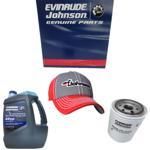0332614 PLATE, Applique, front, 20 EVINRUDE
E20CRCCA, E20CRCUR, E25ECCM, E25ECUA
PLATE

Price: query
Rating:
BRP EVINRUDE entire parts catalog list:
- ENGINE COVER - JOHNSON » 0332614
E25ECCM, E25ELCCM, E25RCCA, E25RLCCA, E25TECCA, E25TELCCA 1988
E25ECUA, E25ELCUA, E25RCUR, E25RLCUR, E25TECUR, E25TELCUR 1987
Information:
Table 1
Diagnostic Trouble Codes
J1939 Code Description
(code descriptions may vary) System Response
4214-5 Engine Fan Reverse Actuator : Current Below Normal This code indicates that there is an open circuit in the engine reversing fan solenoid circuit.
4214-6 Engine Fan Reverse Actuator : Current Above Normal This code indicates that there is a short circuit in the engine reversing fan solenoid circuit.
Illustration 1 g03685569
Table 2
Troubleshooting Test Steps Values Results
1. Determine the Diagnostic Code
A. Establish communication between Caterpillar Electronic Technician (Cat® ET) and the engine Electronic Control Module (ECM). Refer to Troubleshooting, "Electronic Service Tools", if necessary.
B. Download the "Warranty Report" from the engine ECM before performing any troubleshooting or clearing diagnostic trouble codes.
C. Look for an active or logged -5 code or -6 code.
Active codes
Result: An active or logged -5 code is present.
Proceed to Test Step 2.
Result: An active or logged -6 code is present.
Proceed to Test Step 3.
2. Check for an Open Circuit
A. Turn the keyswitch to the OFF position.
B. Disconnect the engine reversing fan solenoid connector from the wiring harness.
C. Verify that the harness connector is free of debris, free of corrosion and was securely connected.
D. Connect a jumper wire between the terminals of the harness connector for the engine reversing fan solenoid. The solenoid coil is replaced with a short circuit.
E. Turn the keyswitch to the ON position
F. Use the "Engine Reversing Fan Solenoid Override" in Cat® ET to turn the solenoid ON.
G. Check for active codes.
Short circuit
Result: A -5 code became active.
An open circuit has been detected in the wiring harness.
Repair the wiring or replace the wiring.
Proceed to Test Step 4.
Result: A -6 code became active.
The short circuit was detected by the ECM
Replace the engine reversing fan solenoid.
Proceed to Test Step 4.
3. Check for a Short Circuit
A. Turn the keyswitch to the OFF position.
B. Disconnect the engine reversing fan solenoid connector from the wiring harness.
C. Verify that the harness connector is free of debris, free of corrosion and was securely connected.
D. Turn the keyswitch to the ON position
E. Check for active codes.
Open circuit
Result: A -5 code became active.
The open circuit was detected by the ECM.
Replace the engine reversing fan solenoid.
Proceed to Test Step 4.
Result: A -6 code became active.
A short circuit has been detected.
Repair the wiring or replace the wiring.
Proceed to Test Step 4.
4. Check the Engine Reversing Fan Operation
A. Start the engine.
B. Activate the engine reversing fan using the engine reversing fan switch.
Switch Result: The engine reversing fan is not operating properly.
Proceed to Test Step 5.
Result: The engine reversing fan is operating properly.
Return the unit to service.
5. Check the Engine Reversing Fan Switch
A. Disconnect the engine reversing fan solenoid connector from the wiring harness.
B. Use a jumper wire to short circuit the signal and ground wires together on the harness side of the connector for the switch.
C. Turn the keyswitch to the ON position
D. Connect to Cat® ET. Monitor the engine reversing fan switch parameters in the status screen.
E. Wait at least 30 seconds and check the status of the engine fan reverse switch on Cat® ET. The correct status for the switch is ON while the jumper wire is in place.
F. Remove the jumper wire from the connector. Wait at least 30 seconds and check the status of the engine fan reverse switch on Cat® ET. The correct status for the switch is OFF with the jumper wire removed.
Status change Result: The switch status changed in Cat® ET.
A failed engine reversing fan switch has been detected.
Replace the engine reversing fan switch.
Verify that the problem has been resolved. Return the unit to service.
Result: The switch did not change status in Cat® ET.
A wiring problem between the switch and the ECM has been detected.
Repair or replace the wiring harness between the switch and the engine harness.
Verify that the problem has been resolved. Return the unit to service.
Complete the procedure in the order in which the steps are listed.
Parts plate EVINRUDE:
0324318

0324318 PLATE, Leaf
25904R, B25JREUR, BE20SEECB, BE20SEEDA, BE20SEEUM, BE20SRECB, BE20SREDA, BE20SREUM, BE25BAECM, BE25BAEDR, BE25EECE, BE25EEDM, BE25EEUB, BE30BAECS, BE30BAEDE, BE30BAEEC, BE30BAEUD, BE30BASIA, BE30BASSR, BE30EECS, BE30EEDE, BE30EEUD, E20CRCCA, E20CRCDC
0208424
0208424 PLATE, Handle support
25904R, B25JREUR, BE20SRECB, BE20SREDA, BE20SREUM, BE25BAECM, BE25BAEDR, BE30BAECS, BE30BAEDE, BE30BAEEC, BE30BAEUD, BE30BASIA, BE30BASSR, E20CRCCA, E20CRCDC, E20CRCEM, E20CRCUR, E20CREDA, E20CREIE, E20CREND, E20CREOR, E20CRERC, E20CRESB, E20CRETS, E
0327944

0327944 PLATE,Throttle control
B25JREUR, BE10EEDD, BE10FAEDC, BE10FAEUR, BE10RELEUS, BE15EEDS, BE15RELEUC, BE20SRECB, BE20SREDA, BE20SREUM, BE25ARECA, BE25AREDC, BE25AREUR, BE25BAECM, BE25BAEDR, BE30BAECS, BE30BAEDE, BE30BAEEC, BE30BAEUD, BE30BASIA, BE30BASSR, BE35ARECR, BE35AREDS
0210646
0210654
0210647
0210655
0332620

